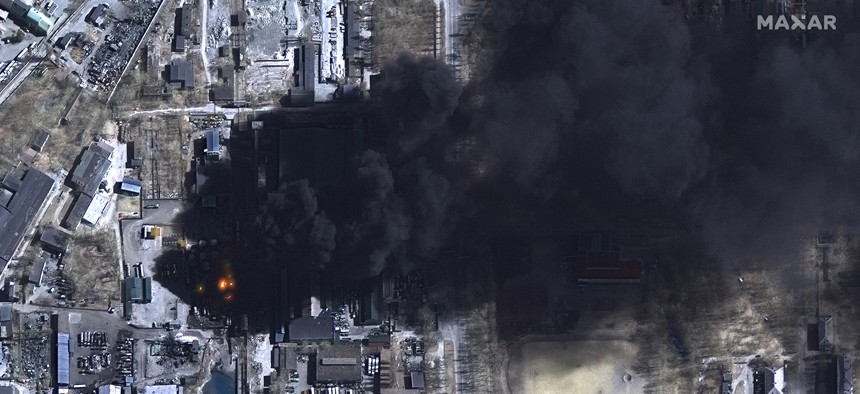TARA COPP

Mere months ago, Ukraine’s space program struggled to compete for funding and wasn’t seen as integral to national defense–but that’s completely changed now, the former head of its space agency said at the Space Innovation Summit on Monday.
Before Russia’s February invasion, Ukrainian officials viewed space as “not so critical for national defense–that you should not spend a lot of money on space–because it's expensive, and you should maybe spend on something much more clear, down to Earth. It will be easier to explain after and before the elections,” said Volodymyr Usov, former chairman of the State Space Agency of Ukraine.
Kyiv officials “had years of discussions” but never committed the funding to obtain its own imagery satellites. It was completely reliant on Western partners and commercial imagery from firms like Maxar to show the world what was happening when Russia invaded.
That was the first lesson, Usov said.
“Every nation who claims to be independent…needs to have its own [imagery] constellation,” Usov said. Even though partnerships help, “you need to have some autonomous access to satellite imagery.”
Lesson two was the need for resilient satellite-based communications. As Russia took out telephone lines, Elon Musk’s Starlink terminals filled in the gaps.
“When you are under the invasion or under war conditions and circumstances, we saw that the first thing that goes down is traditional cable internet,” Usov said. “The only option to connect people to each other was Starlink.”
At one point more than half of Starlink’s global usage came from Ukraine, Usov said.
“You cannot think about a more sustainable way of communicate [connecting] people with each other than having your infrastructure in orbit. Of course, theoretically, it can be destroyed, it can go down. But the resources you need to make this happen is incomparable to the resources you can use to destroy the stations on the ground,” he said.
A third lesson: it’s not just about the satellites. The war has also taught Ukraine it needs its own way to put spacecraft in orbit—and a method that does not highlight to an enemy when a satellite is going up.
“We need to understand that satellites won't go to orbit on their own,” Usov said. “We need autonomous access to space to make it happen. Autonomous access to space is also connected to ground infrastructure. It's expensive, it's complicated, and it's very visible for potential adversaries.”
He said Ukraine is considering models that disguise launches, such as the Virgin Orbit plane or Northrop Grumman’s similar earlier Pegasus Rocket. Both systems use aircraft to get a satellite aloft, then a rocket booster to put it into low-Earth orbit.
Ukraine is even considering a system that would load the satellite, the booster, and the rocket fuel inside a medium-range aircraft. The rocket would be fueled only after the aircraft takes off, concealing launch plans from foes, Usov said.
“We won't need a special infrastructure for fueling rockets prior to start … and it can be done on board our medium-range aircraft so nobody will understand the rocket is going out until it's on the altitude of 10,000 meters.”
A last and critical lesson is that without access to satellite imagery, it would be nearly impossible for Ukraine to report the alleged war crimes that are occurring. The Ukraine war is likely to be the first where the International Criminal Court relies on satellite imagery to prosecute those accused, Usov said.
All this has changed the discussions in Kyiv, Usov said.
“As I talk now to the chairman of the space agency, they're bringing some new ideas to the National Space Program that will be accepted by the Parliament” to not only build native satellites but be ready to more fully invest with allies and partners in space programs, Usov said.
“Now we see a completely different picture…for military intelligence or just to plan and organize what's going on on the battlefield, but also to fix all the atrocities being done by Russian army troops. I think that's almost impossible without having really high precision remote sensing services.”
No comments:
Post a Comment